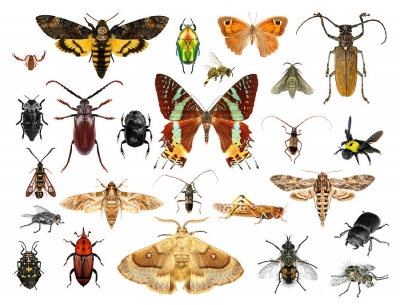WHAT ARE INSECTS?

Insects are small animals with no bones. An insect's body is protected by a hard outer covering called an exoskeleton. The body has three segments: head, thorax and abdomen. The head has eyes - which can have six to 30,000 lenses - and a pair of antennae to feel, taste and smell things. The thorax has wings and legs. The abdomen includes systems for digesting food.
The insects have proved to be the most successful arthropods. There are far more species in the class Insecta than in any other group of animals. These amazingly diverse animals have conquered all the environments on earth except for the frozen polar environments at the highest altitudes and in the immediate vicinity of active volcanoes.
Insects are the only invertebrates (animals without backbones) with wings. Much of their success results from their ability to fly and colonise new habitats. The study of insects is called entomology and entomologists are scientists who study insects.
Insects play a very important role in the web of life, in every environment. Some of their jobs include pollinating flowering plants, being a source of food for insectivorous animals and assisting in the decomposition of plants and animals.
Insect classification
Modern insect classification divides the Insecta into 29 orders, many of which have common names. Some of the more common orders are:
Mantodea - praying mantids
Blattodea - cockroaches
Isoptera - termites
Siphonaptera - fleas
Odonata - dragonflies and damselflies
Dermaptera - earwigs
Diptera - flies
Lepidoptera - butterflies and moths
Orthoptera - grasshoppers, katydids, crickets
Coleoptera - beetles
Hymenoptera - wasps, bees, ants, sawflies
Insect features
The insect body is divided into three main parts, the head, thorax and abdomen.
Insects have no internal skeleton, instead they are covered in an external shell (exoskeleton) that protects their soft internal organs.
No insect has more than three pairs of legs, except for some immature forms such as caterpillars that have prolegs. These are appendages that serve the purpose of legs.
The typical insect mouth has a pair of lower jaws (maxillae) and upper jaws (mandibles) which are designed to bite. There are many variations to this structure, as many moths and butterflies have tubular sucking mouthparts, many bugs and other blood-sucking insects have sucking stabbing mouthparts and some adult insects simply don't have functional mouthparts.
Insects have one pair of antennae located on the head
Most insects have one or two pairs of wings although some insects such as lice, fleas, bristletails and silverfish are completely wingless.
Credit : Australian.museum
Picture Credit : Google
Comments
No comments